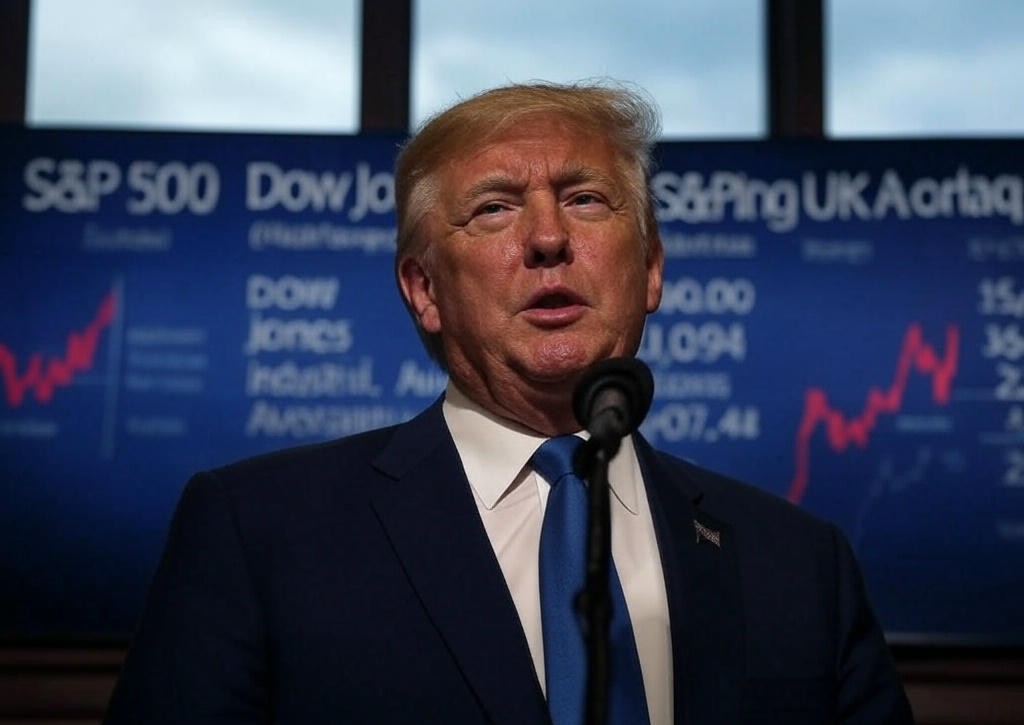The U.S. stock market saw a slight rise today with the Dow Jones Industrial Average, S&P 500 and Nasdaq all moving higher. Investors were encouraged by news of a potential trade deal between the United States and the United Kingdom announced by President Donald Trump. However the excitement was tempered by ongoing worries about tariffs which continue to create uncertainty in the market.

A Boost from the U.S.-UK Trade Deal
The big news driving the market today was President Trump’s announcement of a trade deal framework with the UK. This agreement is the first major trade move since the U.S. introduced broad tariffs on many countries earlier this year. According to reports the deal will lower tariffs on certain UK goods like autos, steel and aluminum while keeping a 10% baseline tariff on other British exports. This is seen as a positive step especially for companies like Boeing which could benefit from increased UK purchases of American aircraft.
The deal has sparked optimism because it signals that the U.S. is open to negotiating trade agreements to ease tensions caused by tariffs. For investors this is a sign that global trade might become less restrictive which could boost economic growth and corporate profits. Stocks rose as a result with the Dow gaining about 0.6% the S&P 500 up by 0.58% and the Nasdaq climbing 1.07% on the day the deal was announced.
The UK deal also raised hopes for similar agreements with other countries, like China where trade talks are ongoing. If more deals are struck it could reduce the economic strain caused by high tariffs and help stabilize markets. For now the market is riding a wave of cautious optimism with investors hoping this is the start of a broader effort to resolve trade disputes.
Tariff Uncertainties Keep Investors on Edge
While the U.S.-UK trade deal is a step forward the market remains nervous about tariffs. Earlier this year President Trump introduced sweeping tariffs on nearly all goods entering the U.S. including a 10% baseline tariff and higher rates for specific countries. These tariffs announced on April 2 as part of Trump’s “Liberation Day” policy caused a sharp drop in stock prices with the S&P 500 falling nearly 15% at one point.
Although Trump paused some tariffs for 90 days to allow negotiations the uncertainty about what happens next is weighing on investors. For example tariffs on Chinese goods were reduced from 145% to 30% and China lowered its tariffs on U.S. goods from 125% to 10%. But these cuts are temporary set to expire in early July unless new agreements are reached. If no progress is made tariffs could rise again hurting businesses and consumers.
Companies like Foxconn a major electronics manufacturer have already warned that tariff uncertainty is hurting their outlook. Others like Sony have seen profits shrink due to higher costs. This uncertainty makes it hard for businesses to plan, hire or invest which can slow economic growth and keep stock markets volatile.
Investors are also watching upcoming economic data like the Consumer Price Index (CPI) and Producer Price Index (PPI) to gauge how tariffs are affecting inflation. Higher tariffs could drive up prices which might force the Federal Reserve to keep interest rates high making borrowing more expensive and potentially slowing the economy.
What’s Next for the Stock Market?
The stock market’s recent gains show that investors are hopeful about trade deals but the road ahead is far from clear. The U.S.-UK deal is a positive signal but it’s limited in scope. Experts warn that the 10% baseline tariff on UK goods suggests high tariffs may remain a longterm reality for other countries too. This could keep businesses cautious limiting hiring and investment.
The U.S.-China trade talks happening in Switzerland are another critical piece of the puzzle. A successful outcome could further boost stocks especially for tech companies like Apple, Tesla and Nvidia which rely on Chinese markets and supply chains. On Monday when the U.S. and China announced a temporary tariff cut the Dow jumped 1160 points the S&P 500 rose 3.26% and the Nasdaq surged 4.35%. A similar rally could happen if more progress is made but failure to reach a deal could send stocks lower.
Investors should also keep an eye on Trump’s trade strategy. Some analysts believe he’s using “strategic uncertainty” to push for better deals but this approach keeps markets volatile. For example stocks dipped on May 6 when Trump’s comments on trade deals were vague with the Dow falling 389 points. Clearer communication from the administration could help calm markets.
Key Takeaways for Investors
For now the U.S. stock market is balancing hope and caution. The U.S.-UK trade deal has lifted spirits but tariff uncertainties and their economic impacts are keeping investors on edge. Here are a few things to watch:
- Trade Talks: Progress with China and other countries could drive more market gains while setbacks could lead to sell offs.
- Economic Data: Inflation reports like CPI and PPI will show how tariffs are affecting prices which could influence Federal Reserve policies.
- Company Earnings: Businesses are still grappling with tariff related costs so their earnings reports will offer clues about future market trends.
- Trump’s Moves: The president’s statements and actions on trade will continue to sway markets so staying informed is crucial.
In conclusion the U.S. stock market is at a crossroads. The Dow, S&P 500 and Nasdaq are benefiting from trade deal optimism but the shadow of tariffs looms large. Investors should stay vigilant keeping an eye on trade developments and economic indicators. While the market has recovered much of its losses from the April tariff shock the path forward depends on how global trade tensions unfold. For now it’s a time to be hopeful but cautious as the balance between opportunity and risk remains delicate.
